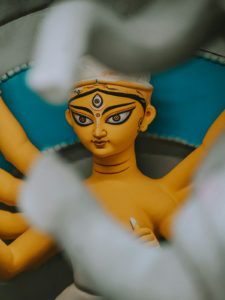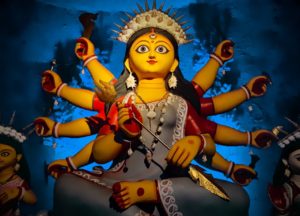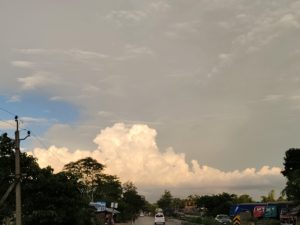By Jnanendra Das
 As the calendar inches closer to Durga Pujo, there’s an unmistakable change in the air. For Bengalis worldwide, the days leading up to this grand festival are filled with an electric mix of excitement, nostalgia, and devotion. It’s not just the arrival of a festival; it’s the arrival of a feeling – the “Pujo Pujo Bhab” – that sweeps over hearts and streets alike. And this year, as we stand just two days away from Shashti, the anticipation feels more palpable than ever.
As the calendar inches closer to Durga Pujo, there’s an unmistakable change in the air. For Bengalis worldwide, the days leading up to this grand festival are filled with an electric mix of excitement, nostalgia, and devotion. It’s not just the arrival of a festival; it’s the arrival of a feeling – the “Pujo Pujo Bhab” – that sweeps over hearts and streets alike. And this year, as we stand just two days away from Shashti, the anticipation feels more palpable than ever.
The days before Durga Pujo are magical. The wilderness is adorned with the swaying Kans Grass (Kashful), painting the fields with a gentle, silvery white. The scent of night-blooming jasmine (Shiuli flowers) fills the crisp morning air, while the horizon is dotted with clouds that seem like soft cotton candy, reminiscent of the divine mother’s embrace. These are the days that set the perfect tone for the festival, where the sound of dhak beats starts to echo in the minds of all those eagerly awaiting the four sacred days.
 Pujo pandals are buzzing with final preparations. Artisans, who have been working tirelessly for months, add the last strokes of their brushes to the idols of Goddess Durga. Soon, we will witness her majestic form, poised to slay the demon Mahishasura and bless the earth with her presence. For Bengalis, the wait of an entire year will finally end, only to be followed by the bittersweet reality that the cherished four days will slip away in the blink of an eye. And then, just like that, the goddess will leave for Kailash, leaving behind memories and the yearning for her return.
Pujo pandals are buzzing with final preparations. Artisans, who have been working tirelessly for months, add the last strokes of their brushes to the idols of Goddess Durga. Soon, we will witness her majestic form, poised to slay the demon Mahishasura and bless the earth with her presence. For Bengalis, the wait of an entire year will finally end, only to be followed by the bittersweet reality that the cherished four days will slip away in the blink of an eye. And then, just like that, the goddess will leave for Kailash, leaving behind memories and the yearning for her return.

But it’s in the days between Mahalaya and Shashti that the true spirit of Durga Pujo builds. These six days, often described as the “best days” by Bengalis, hold a unique charm. The “Pujo Pujo Bhab” is at its peak, making it nearly impossible to contain the growing excitement. Mahalaya, which kickstarts the Durga Pujo festivities, marks the end of Pitru Paksha – a period of mourning – and the beginning of Devi Paksha, the fortnight of the goddess. It’s a day steeped in legend, where Goddess Durga’s victory over Mahishasura is celebrated, and her journey to earth begins.

At dawn on Mahalaya, a timeless tradition unfolds. Across India, All India Radio stations play the iconic Mahisasuramardini programme, narrated by the legendary Birendra Krishna Bhadra. For generations, his resonant voice and baritone have filled homes, awakening listeners at the crack of dawn to the powerful tale of Durga’s triumph over evil. The 1-hour 29-minute broadcast, which first aired in 1931, has become an inseparable part of Mahalaya and also the longest-running radio programme in India. Scripted by Bani Kumar and set to music by Pankaj Mullick, this programme is more than just a ritual; it’s an emotion. Even in the age of digital streaming, the sound of Bhadra’s voice crackling through a radio transistor holds a certain magic that no modern device can replicate.
Many families in Bengal and beyond still wake up early on Mahalaya, gather around their radios, and soak in the powerful storytelling. On the dawn of Mahalaya which culminates the Pitru and Devi Paksha, people perform “Tarpan” – a heartfelt offering of water and prayers to ancestors, performed near rivers, ponds, or any water body. It’s a poignant reminder of the cycle of life, where homage is paid to the departed before welcoming the goddess to earth.
As the week after Mahalaya progresses, so does the last-minute rush for Durga Pujo preparations. For many, this is the final leg of the shopping marathon that started weeks ago. New clothes are an essential part of the celebrations, with everyone – from toddlers to grandparents – ready to showcase their finest attire during the four-day festival. And for the “Probashis” (Bengalis living away from home), it’s the time to pack their bags and return to their roots, reconnecting with family and friends in a celebration of togetherness.
Then, finally, Shasti arrives, and with it, the vibrant celebrations that will light up cities, towns, and villages for the next four days. In places like Meghalaya, which hosts some of the most spectacular Durga Pujo in the Northeast, people flock to renowned pandals like Rilbong, Jail Road, Rynjah, Hindu Mission (Mawprem), Rajbari Para Pujo Committee (Polo Hills), Shiv Mandir (Tura), Ramakrishna Mission (Laitumkhrah), among others. Devotees also make their way to the ancient Durga temple at Nartiang in the Jaintia Hills, a revered Shakti Peetha that has stood for over 600 years. Each of these locations boasts intricate decorations, unique themes, and a palpable sense of devotion that draws thousands of visitors year after year.
As the days of Shasti, Saptami, Ashtami, and Navami unfold, time seems to slip away, as if Durga herself bends it to make the celebrations feel like fleeting moments. The grand aartis, the rhythmic beats of the dhak, the scent of dhunuchi (incense burner) and flowers, and the joy of sharing meals and moments with loved ones fill every heart with bliss. Yet, there’s always an underlying awareness that Dashami, the day of immersion, is near.
Dashami marks the end of Durga Pujo, where, as per legends, the goddess returns to her heavenly abode, and her idols are ceremoniously immersed in rivers. For many Bengalis, this departure is met with a mix of joy and sadness – what is humorously called “Post Pujo Depression.” It gets fixed for a brief period during the Lakshmi Puja or “Lokkhi Pujo” and Diwali and “Kali Pujo” and then starts the waiting for another year for Goddess Durga’s arrival.
Durga Pujo may come and go, but its essence lingers long after. It’s a festival that transcends religion, binding people with love, hope, and a shared belief in the power of good over evil. In the hills of Meghalaya, Durga Pujo is not just a celebration for the Bengali community; the involvement of many other communities adds to the grandeur, making it a truly inclusive and vibrant festival. And as the countdown begins for another year, Bengalis will once again wait patiently, hearts full of devotion, for the next arrival of beloved Durga Maa.



